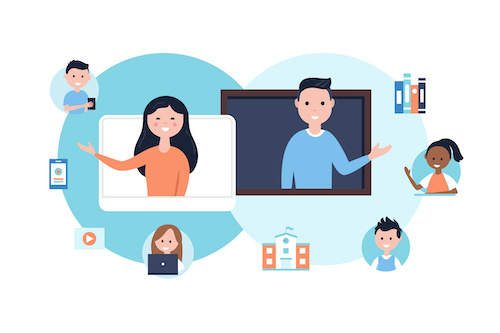Key points:
- Virtual learning expanded access to student mental health support
- Hybrid learning offers improved satisfaction during IEP meetings
- Stay up to date on the latest trends about learning in the digital age
In the business world, we’ve seen a sea change in the way people work. While some have returned to the office full time, some are still working remotely, and others are opting for a hybrid approach of being in-person just a few days a week. If the pandemic showed us anything, it is that flexibility is in the best interest of the employee and the company in a competitive marketplace.
The same lessons are true in schools. Forced to go online, in some cases for a year or more, schools quickly turned to video conferencing and online tools to facilitate the development of Individualized Educational Plans (IEPs) and even deliver mental health services to help students cope with the changes resulting from the pandemic. These new approaches offered ways to reduce many of the traditional barriers to services and support. Plus, they provided flexibility to create individualized plans that best meet the needs of students and their families.
But now that schools are again in-person, does it make sense to resort to the old ways as we look to the future? Having many new, effective tools in educators’ toolboxes, it’s time to cast aside conventional processes and rethink the way we provide services to, and support, our students.
The pandemic effect
School closures and new procedures during the pandemic threw students, parents, teachers, support staff, and administrators into chaos as they tried to navigate remote learning and keep students on track. By the time they returned to classrooms, they had to contend with learning loss and behavioral challenges resulting from the disruptions and isolation during COVID-19.
Students with disabilities who relied on IEPs, however, experienced a bigger negative impact from the pandemic. Data notes that these students saw sharper declines in test scores. For example, reading scores dropped 7 percent for students with disabilities in 2022 compared to pre-pandemic levels, vs. just 5 percent for their peers. Graduation rates were similarly impacted, with nearly half of the states reporting declining graduation rates among students with disabilities in 2021, compared with just 10 states the previous year.
The heart of the problems stemmed from the difficulties meeting requirements for special education under the Individuals with Disabilities Education Act, according to the American Institutes for Research. More than half of school districts surveyed said it was “more difficult” or “substantially more difficult” to provide accommodations and specially designed instruction and related services, along with meeting referral and evaluation procedures and timelines. Another 42 percent indicated they had issues with IEP development and renewal meetings. Among the supports that were most challenging to provide were hands-on accommodations and services, appropriate instructional accommodations, speech therapy, engaging families for help with IEP requirements, and collaborating with social service and other agency partners.
A plus side to remote services?
Despite these negative impacts, there were some upsides to going remote for those with IEPs and the adults supporting them. Even though many students with IEPs or 504 plans reported having problems with remote learning, others blossomed with at-home learning. Quiet spaces, fewer distractions, the ability to work at their own pace and with their best learning style, and less anxiety-producing classroom social pressure allowed these students to flourish. Research shows that school socialization may be distracting or intimidating, which can influence participation and focus in class.
Parents, too, saw benefits to virtual IEP meetings. The Center on Reinventing Public Education (CRPE) noted that parents reported low satisfaction with in-person meetings, as they could feel outnumbered or rushed, and meetings often were missing key members of the school-based team. However, with the pandemic’s virtual meetings, attendance increased, which both parents and educators told CRPE “facilitated higher levels of active engagement in meetings and fostered stronger partnerships between families and the special education teams.” Not only were these meetings easier to schedule to ensure all parties could attend, but there appeared to be more reflection on the purpose of the meetings and preparation, which led to greater collaboration between educators and parents.
Virtual meeting options also improved access to school-provided mental health services. The severe shortage of school psychologists was an issue even before the pandemic. Now, nationally, there is only one school psychologist for every 1,127 kids, with psychologists often serving multiple schools. The experience of providing services during the pandemic revealed the advantages of telecounseling for both students and school psychologists, according to the National Association of School Psychologists (NASP). Virtual appointments enabled psychologists to work with more students as their commuting time between appointments was minimized and they could be more flexible with scheduling. NASP also reported that students preferred telecounseling, too, which resulted in regular attendance and more meaningful participation in the sessions.
Given the feedback from students, parents, educators, and school psychologists about their experience of going virtual during the pandemic, it may be time to consider a more business-like approach to providing school-related services. Much like companies are embracing hybrid work to improve employee satisfaction and productivity, schools should consider reimagining the learning processes – leveraging both in-person and remote services – that enable children to achieve the best possible results.
Related:
Online learning can help schools retain students
5 ways virtual tutoring reinforces our after-school program
- Motivating students using the Self-Determination Theory - April 17, 2024
- Michigan Virtual’s statewide workgroup releasing AI guidance for K-12 educators - April 17, 2024
- 5 obstacles AI can help schools overcome - April 16, 2024

